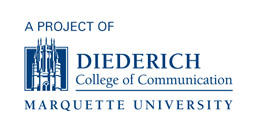
Although by law, data collected by the U.S. Census Bureau is confidential and can’t be shared with any other agency, many Latinos are afraid to participate. (Photo by Edgar Mendez)
Citing extremely low participation rates in Clarke Square for the 2010 decennial census, the Clarke Square Neighborhood Initiative (CSNI) has created its own census, hoping to accurately tally the neighborhood’s demographics.
An accurate count will help CSNI become more informed about the needs of neighborhood residents, according to Diana Vang, CSNI community liaison.
“We don’t have accurate information about our neighborhood and the CSNI census project is our attempt to try to count the entire neighborhood,” Vang said.
Only 53 percent of residents in Clarke Square participated in the 2010 census, down 4 percentage points from 10 years earlier according to the U.S. Census Bureau. The overall participation rate for the city of Milwaukee was 69 percent. About 15 percent of Milwaukee residents are Hispanic.
According to Jenny Negron, who’s lived in the area for 20 years, the low numbers can be attributed to residents’ fears of providing possibly incriminating information.
“People are scared because they’re here illegally,” Negron said. As to whether their fears are warranted, Negron’s not sure, but she’s not alone.
Yanitza Lacen, who lives in the neighborhood, says that people are misinformed about the reasons for the census.
“I’ve heard myself from people who are scared to fill out the census because they lack documents and people could come to look for them, but it’s not true,” Lacen said.
A media campaign created to dispel misconceptions about the census — which emphasized that the data is confidential, isn’t identified by individual and can’t be shared with any other agency — has been only minimally successful.
The U.S Census Bureau has always struggled to accurately tally immigrant-heavy neighborhoods. For example, the nearby Walker’s Point neighborhood had a participation rate of 38 percent. Latinos make up 60 percent of residents in Clarke Square and nearly 75 percent in Walker’s Point, according to city-data.com, compared to 13.3 percent in the city of Milwaukee.
According to the Census Bureau website, the reason questions about race and origin are included in the survey is because the information is critical for making policy decisions, particularly about civil rights.
Another reason for low participation in Clarke Square is the housing stock.
Vang said that along with single-family houses, there are numerous duplexes and triplexes, as well as houses that have up to six different addresses, which makes them difficult to count.
Teresa Sughroue, who lives in Clarke Square and didn’t fill out her census survey, said some people hesitate to participate because they have more people living in their house than they care to report.
“There are too many people, sometimes even 20 living in a single house, and they don’t want to say that,” Sughroue said.
Though Milwaukee has no laws governing how many people can live in a household, zoning laws do forbid dwellings housing more households than they’re designated for. For example, a single-family dwelling is not supposed to house multiple families.
Unlike the census bureau, CSNI is trying to make people comfortable by introducing themselves, showing them literature and explaining how its census is in line with the community’s quality of life objectives, Vang said. Although the new tally won’t affect the census count, it will help serve the needs of residents, added Vang.
For example, the question about educational attainment is related to the “lifelong learning” strategy in the Clarke Square quality of life plan. Vang added that once CSNI learns more about educational levels in the community, it can better focus resources to help residents further their schooling.
The block-to-block process of asking people to answer the seven questions — similar to those asked on the U.S. census form — is expected to run through the spring. Organizers are seeking volunteers to canvass the neighborhood. Volunteers must be 16 years of age and training will be provided. For more information contact Diana Vang (414) 810-2332 or email her at dvang@journeyhouse.org.





